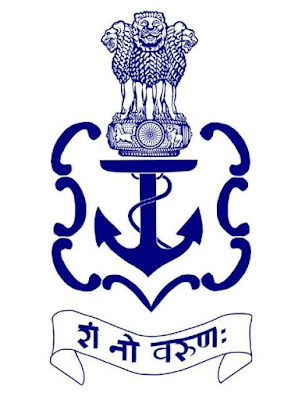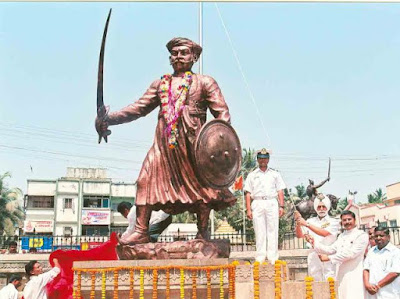Vijaydurg - India's First Naval Base
 |
| Vijaydurg Fort |
 |
| Indian Navy |
In today’s
India, the major bases of the Indian Navy are located at Mumbai, Goa, Karwar,
Kochi, Chennai, Visakhapatnam, Kolkata and Port Blair. The primary objective of
the Navy is to safeguard the nation’s maritime borders and act to deter of
defeat any threats or aggression against the people, territory or maritime
interests of India.
 |
| Vijaydurg |
But all
these started long before India got its freedom. Vijaydurg is a seaport that
was built on the coast of Maharashtra, almost 485 km from Mumbai. In its coast,
there is an abandoned fort. Even though the fort is not so huge but that do not
diminish its significance. Vijaydurg was one of the oldest towns of India. We
can find its reference in the famous book “The Periplus of the Erythraean Sea”.
 |
| Raja Bhoj II |
The fort of
Vijaydurg was first named as “Gheriah” which means boundary. It was named so
because the fort was situated at the boundary of six neighbouring villages.
According to the history, this fort was built by Raja Bhoj II of the Shilahara
Dynasty. The fort was later occupied by the kings of the Bahmani Dynasty. After
the destruction of the Bahmani Empire, the fort came under the rule of the
Bijapur Empire. Chhatrapati Shivaji took this fort from Adil Shah of Bijapur.
After occupying this fort, Shivaji started his conquest and began to occupy the
surrounding areas.
 |
| Chhatrapati Shivaji |
There are
many theories when it comes to the name of this fort. Shivaji won this fort
from Adil Shah in the year 1653. According to the Hindu calendar the name of
that year was “Vijay”. People believe that for this reason Shivaji named this
fort “Vijaydurg”. After occupying this fort he made many arrangements for the
protection of the fort. When Shivaji occupied this fort it was on five acres of
land but later he expanded it to seventeen acres. To expand the area of this
fort he made three boundary walls. These three boundary walls had twenty seven
watch towers. In local language they are called “Chilkhati Tatbandi”. He made
his first naval base in this fort. Vijaydurg fort is made of Laterite stone
which was found in abundance in this region. These stones were paired with
lime, jaggery and lead.
 |
| Dockyard of Vijaydurg |
After
Shivaji came to the Maratha Kingdom, he started strengthening his navy. After
1674 Shivaji started to build his own ships to increase his naval power. He
also made a dockyard to protect his ships from the enemy. In this dockyard his
shipbuilding and repair work was done. He built two war ships named “Fateh
Jung” and “Shumsher Jung”.
 |
| Kanhoji Angre |
The king of Satara made Kanhoji Angre the
chief admiral of the Maratha Navy. Kanhoji Angre made Vijaydurg the head
quarter of Maratha Navy. During that time he built many large ships to
strengthen the Maratha Navy. He built ships with 60-70 cannons. Such ships were
then only available to the English. Maratha Navy was the first Indian to build
such ships. 1698-1729 was the golden period of the Marathas as well as
Vijaydurg’s.
 |
| Underwater Wall of Vijaydurg |
There is
another special feature in this fort. This fort has an underwater wall. The
entire sea side of the fort was surrounded by an underwater wall. Only the
Marathas knew about this underwater wall. Whenever the enemies tried to attack
the fort through the sea, their ships would break against that wall.
 |
| Sambhaji Maharaj |
After the
death of Shivaji in 1680, a cold war was started among the Marathas. At that
time Aurangzeb killed Shivaji’s son Sambhaji. The Marathas started to quarrel
for the throne. At that time of conflict Shivaji’s grandson Chhatrapati Shahu
invented the post of Peshwa (the higher level ministers) to manage his kingdom
well. However after his death, power moved from the ruling Chhatrapati to his
Peshwas.
After the
death of Kanhoji Angre all his wealth moved on to his son Sambhaji Angre. But
after the death of Sambhaji Angre, conflict began between his two brothers
Manaji and Tulaji over the property. Peshwa Nana Saheb solved their problem by
giving Manaji the northern part of the property and Tulaji, the southern part
of the property.
 |
| Battle of Vijaydurg |
Peshwa Nana
Saheb liked Manaji over Tulaji. The reason of hatred was that Tulaji did not
agree to pay Nana Saheb the revenue tax. After the death of Chhatrapati Shahu
in 1750, when the power moved to the Peshwas, Nana Saheb signed an agreement
with the British against Tulaji. The British attacked Tulaji through sea route
and Nana Saheb attacked Tulaji through land. At the end of a war the British
occupied this fort on 11th February, 1756. The British liked this
fort very much for its features and they refused to return the fort to the
Peshwa.
In the end
British agreed to give Peshwa the fort of Vijaydurg. But before leaving the
British looted the money and all valuable things form there and set the fort on
fire. The fort was destroyed and over time it became totally abandond.
 |
| Sir Norman Lockyer |
But history
doesn’t end here. This fort is also famous for another reason. In 1868, an
English scientist and astronomer, Sir Norman Lockyer came to this Vijaydurg
fort to do some research on solar eclipse. From this place he discovered the
presence of Helium gas in the sun. From that time Vijaydurg has been known as
the place of the discovery of Helium.
 |
| Jakhni Chi Toop |
Let me share
another interesting fact about this place. People of Vijaydurg still worship
one of the cannons of Shivaji. Suresh Sawant is one of the residents of
Vijaydurg. His family has been worshiping the cannon for generations. The name
of the cannon is “Jakhni Chi Toop” (meaning “Cannon of the Witch"). The rituals
are not like any ordinary worship. This ritual has to be done with egg and
vermilion. When it was asked to him about the extraordinary ritual of
worshipping the cannon, he told a very interesting story about the history of
the cannon. According to him a witch dwells in the cannon. In earlier times
when the enemy attacked Vijaydurg, they were first fired at with the special
cannon. It was believed that by firing from the cannon they were unleashing the
witch on their enemies. That made it impossible for their enemies to win.
After
learning all these, I think Vijaydurg fort is a must to visit place. If you like
my effort please leave a comment below.



Comments
Post a Comment